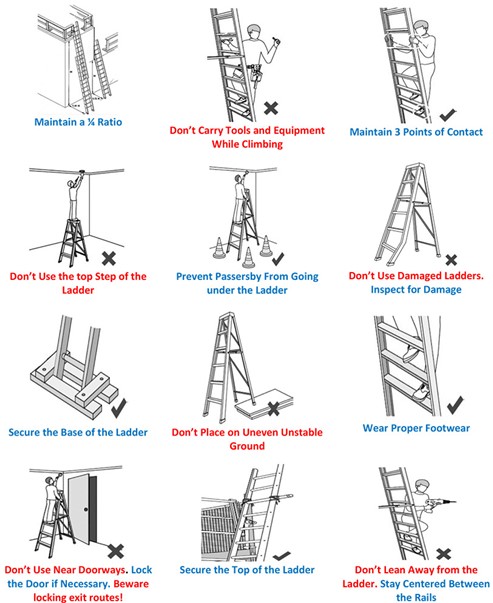Ladders are one of the most useful tools on a job site. Therefore, OSHA has very strict regulations about the use of ladders off the ground such as on roofs, manlifts or stairs. Over the years, safety administrations, employers and ladder manufacturers alike have made it a priority to improve education regarding ladder safety to help keep others safe. Using a ladder incorrectly can come with a steep cost: injury or even death. Following some basic ladder safety tips can help to avoid OSHA citations involving ladder usage and will encourage working safer, allowing your safe return home to friends and family.
Every year there are over one hundred and fifty thousand emergency room visits and 300 deaths from ladder falls. Amazingly most of the deaths are from falls of 10 feet or less. By carefully following safety protocols when using ladders, injuries and deaths can be significantly reduced. It may save your life or the life of someone in your organization.
Factors that contribute to falls from ladders include:
- Haste or sudden movement
- Overreaching
- Carrying objects and not maintaining three points of contact
- Lack of attention
- Improper climbing posture, such as standing too high or straddling the ladder
Ladder Inspection
Before using your ladder, it is important to inspect it, especially if you aren’t the only person using the ladder. Check it for dents, cracks, and fiberglass bloom. Look at the treads on the feet of the ladder to ensure that your ladder is safe for use. If your ladder is damaged or questionable, do not use it. Your safety matters, and a damaged ladder puts your safety at risk.
The 4:1 Ratio
When using an extension ladder, remember this ratio: for every four feet of ladder length, the base of the ladder needs to be pulled one foot away from the wall. This ratio keeps your ladder stable as you climb and prevents the ladder from sliding out. If your ladder is in the right position, you should be able to touch the rungs of your ladder without adjusting.
Maintaining Three Points of Contact
When you’re working at the top of a ladder, it is imperative to maintain three points of contact with the ladder. Typical points of contact include the hands, feet, or knees, meaning you should have both feet firmly planted on the ladder, with a hand or your knees resting on the ladder for stability. When you lose your third point of contact, you are more likely to lose balance, which can result in an injury.
Overreaching
This seemingly mild action leads to the most severe and catastrophic ladder-related injuries. It also directly correlates to the point above—maintaining three points of contact. When you don’t maintain three points of contact, you are more likely to overreach, and when you overreach, your ladder loses balance. As frustrating as it may be to climb to the bottom of the ladder, just to reset it and climb back up, it is so important. While at the top of the ladder, a good rule of thumb is to keep your belt buckle between the rails. If you find that your belt buckle is beyond the side rails, you have reached too far.

Related Topics: Newsletter, Workplace Safety, Ladder Safety, Safety Tips, Accident Prevention, Jobsite Safety, Monthly Safety Topics, Safety Articles